20,000 Leagues Under the Sea (1954 film)
8 /10 1 Votes
89% Rotten Tomatoes Genre Adventure, Drama, Family Duration Language English | 7.2/10 IMDb Country United States | |||||||||||||||||||||||||||||||||
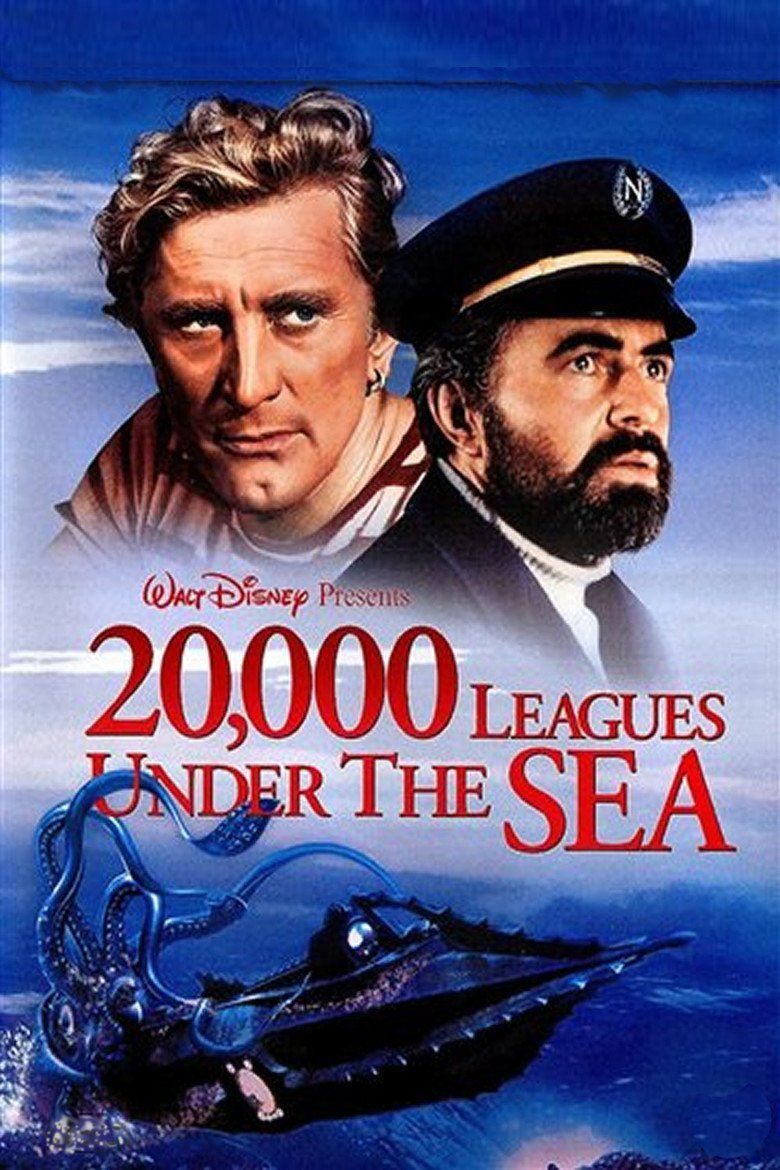 | ||||||||||||||||||||||||||||||||||
Release date December 23, 1954 (1954-12-23) Cast (Ned Land), (Captain Nemo), (Prof. Pierre Arronax), (Conseil), (First Mate of the Nautilus), (Capt. Farragut) Similar movies Pirates of the Caribbean: On Stranger Tides , Pirates of the Caribbean: At World's End , Pirates of the Caribbean: Dead Man's Chest , The Big Blue , Black Sea , The Abyss Tagline The mightiest motion picture of them all! | ||||||||||||||||||||||||||||||||||
20,000 Leagues Under the Sea is a 1954 American Technicolor adventure film and the first science fiction film shot in CinemaScope. The film was personally produced by Walt Disney through Walt Disney Productions, directed by Richard Fleischer, and stars Kirk Douglas, James Mason, Paul Lukas and Peter Lorre. It was also the first feature-length Disney film to be distributed by Buena Vista Distribution. The film is adapted from Jules Verne's 19th-century novel Twenty Thousand Leagues Under the Sea. It is considered an early precursor of the steampunk genre.
Contents
- Plot
- Production
- Upon release
- Critical opinion
- Awards and nominations
- Record albums
- Official soundtrack
- In Disney resorts
- Home media
- Comic book adaptation
- Remake
- References
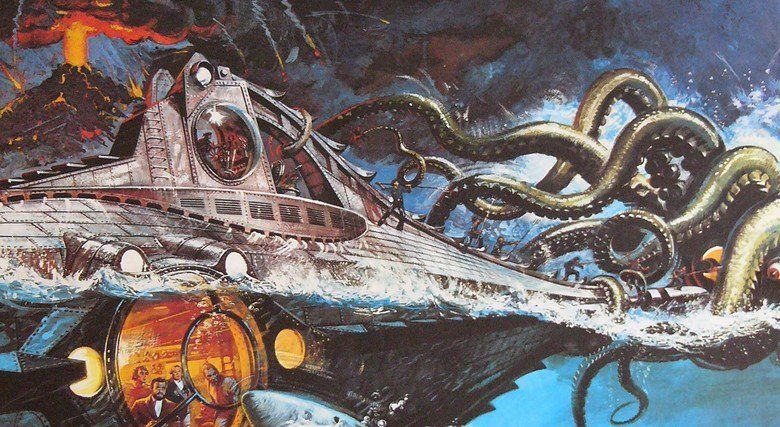
Plot
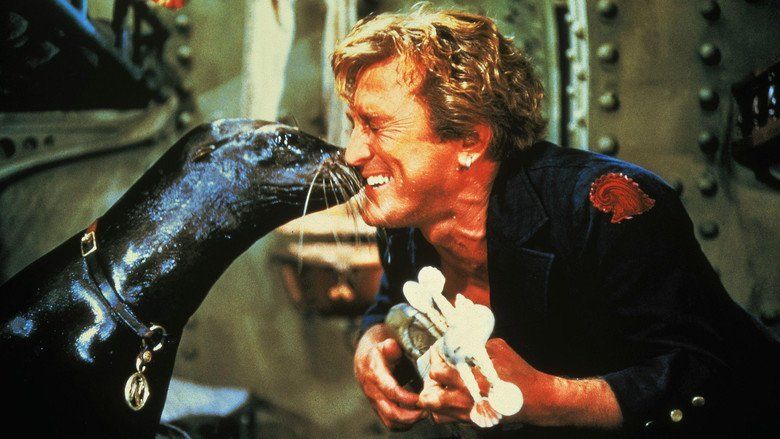
In 1868, rumors of a sea monster attacking ships in the Pacific Ocean have disrupted shipping lanes. The United States invites Professor Pierre M. Aronnax and his assistant, Conseil, onto an expedition to prove the monster's existence. On board with them is the cocky master harpooner Ned Land.
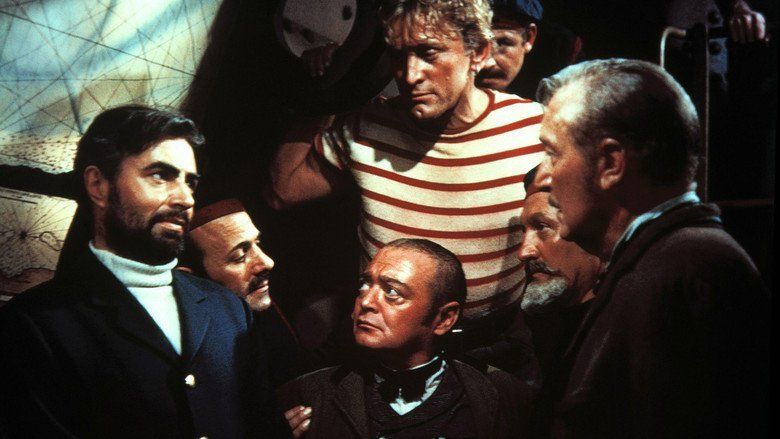
After months of searching, the "monster" is spotted shortly before it rams the ship. Ned and Aronnax are thrown overboard, and Conseil goes in after Aronnax. The warship, burning and helpless, drifts away, and no one aboard responds to the overboard passengers. The three find a strange-looking metal vessel, and realize the "monster" is a man-made "submerging boat" that appears deserted. Aronnax finds a large viewport and witnesses an underwater funeral.
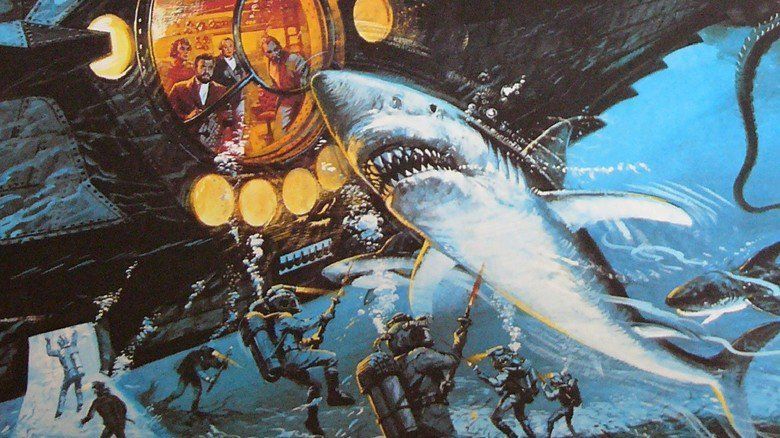
Ned, Aronnax, and Conseil attempt to leave in their lifeboat, but the submarine crew stops the castaways. The captain introduces himself as Nemo, master of the Nautilus. He returns Ned and Conseil to the deck while offering Aronnax, whom he recognizes for his work, the chance to stay. After Aronnax proves willing to die with his companions, Nemo allows Ned and Conseil to remain.

Nemo takes them to the penal colony island of Rura Penthe. Nemo was a prisoner there, as were many of his crew. The prisoners are loading a munitions ship. The Nautilus rams it, destroying its cargo and killing the crew. An anguished Nemo tells Arronax that his actions have saved thousands from death in war; he also discloses that this "hated nation" tortured his wife and son to death while attempting to force him to reveal the secrets of his work. Ned discovers the coordinates of Nemo's secret island base, Vulcania, and releases messages in bottles, hoping somebody will find them.

Off the coast of New Guinea, the Nautilus becomes stranded on a reef. Ned is surprised when Nemo allows him to go ashore with Conseil, ostensibly to collect specimens. Ned goes off alone to explore avenues of escape. While drinking from a pool he sees human skulls on stakes. Ned runs for his life and rejoins Conseil as they are pursued by cannibals. The cannibals are repelled from the ship by electrical charges through its hull. Nemo is furious with Ned for disobeying his orders, confining him to the brig.
A warship approaches, firing upon The Nautilus, which descends into the depths, where it attracts a giant squid. After an electric charge fails to repel the monster, Nemo and his men surface to dislodge it. Nemo is caught in one of its tentacles. Ned, having escaped from captivity, saves Nemo's life. Nemo has a change of heart and claims he wants to make peace with the world.
As the Nautilus nears Vulcania, Nemo finds the island surrounded by warships whose marines are converging on his base. As Nemo goes ashore, Ned attempts to identify himself as the author of the bottled messages. Aronnax is furious, recognizing that Nemo will destroy all evidence of his discoveries. Nemo enters the base and plants a bomb, but is mortally wounded on the Nautilus's deck from a slug to the back. After navigating the submarine away from Vulcania, Nemo announces he will be "taking the Nautilus down for the last time". Nemo's crew declare they will accompany their captain in death.
Aronnax, Conseil, and Ned are confined to their cabins. The Nautilus's crew also retreat to their cabins at Nemo's instructions. Ned escapes and manages to surface the Nautilus, hitting a reef in the process and causing the boat to flood. Nemo staggers to his viewport, watching his beloved sea as he dies.
Aronnax tries retrieving his detailed journal, but the urgency of their escape obliges Ned to knock him unconscious and carry him out. The companions witness Vulcania explode, and Ned apologizes to Aronnax for hitting him. As the Nautilus disappears beneath the waves, Nemo's last words to Aronnax echo: "There is hope for the future. And when the world is ready for a new and better life, all this will someday come to pass, in God's good time".
Production
20,000 Leagues Under the Sea was filmed at various locations in The Bahamas and Jamaica, with the cave scenes filmed beneath what is now the Xtabi Resort on the cliffs of Negril. Filming began in spring of 1954. Some of the location filming sequences were so complex that they required a technical crew of more than 400 people. The film presented many other challenges, as well. The famous giant squid attack sequence had to be entirely re-shot, as it was originally filmed as taking place at dusk and in a calm sea. The sequence was filmed again, this time taking place at night and during a huge gale, both to increase the drama and to better hide the cables and other mechanical workings of the animatronic squid.
Cost overruns during production made the film very expensive for a Disney production, although by no means as expensive as other recent releases: Joan of Arc (1948) had cost $4.6 million; Quo Vadis (1951) had an estimated budget of $7.6 million.
Upon release
Upon the film's original release, The New York Times film critic Bosley Crowther gave it a generally positive review by stating that, "As fabulous and fantastic as anything he has ever done in cartoons is Walt Disney's "live action" movie made from Jules Verne's '20,000 Leagues Under the Sea.' Turned out in CinemaScope and color, it is as broad, fictitiously, as it is long (128 minutes), and should prove a sensation—at least with the kids." In his 1967 biography The Disney Version, the critic, Richard Schickel, stated that James Mason was "superbly cast as the mad inventor Captain Nemo".
The film was also praised for the performances of the leading actors. This was the first time that major international stars such as Kirk Douglas, James Mason, and Peter Lorre had appeared in a Disney film, although Robert Newton, a well-known actor in British films, had played Long John Silver in Disney's Treasure Island (1950), and Richard Todd, another well-known British actor, had appeared in Disney's Technicolor live-action version of The Story of Robin Hood and His Merrie Men (1952). Mason especially was singled out for his performance of Captain Nemo. Many people who had first seen him on-screen in the film identify him most strongly with this role.
20,000 Leagues Under the Sea received positive reviews from critics, was the second highest-grossing film of the year (behind White Christmas), earning $8 million in box office attendance in North America and has become a notable classic film of the Disney corporation.
Critical opinion
Modern-day film critic Steve Biodrowski said that the film is "far superior to the majority of genre efforts from the period (or any period, for that matter), with production design and technical effects that have dated hardly at all." Biodrowski also added that the film "may occasionally succumb to some of the problems inherent in the source material (the episodic nature does slow the pace), but the strengths far outweigh the weaknesses, making this one of the greatest science-fiction films ever made."
Audiences remember it primarily for its giant-squid battle sequence as well as the Nautilus itself and James Mason's portrayal of Nemo. The film currently holds an 89% approval rating at the review aggregator website Rotten Tomatoes, with the consensus being: "One of Disney's finest live-action adventures, 20,000 Leagues Under the Sea brings Jules Verne's classic sci-fi tale to vivid life, and features an awesome giant squid."
Awards and nominations
The film won two Academy Awards and was nominated for one more.
The film's primary art designer, Harper Goff, who designed the Nautilus, was not a member of the Art Directors Union in 1954 and therefore, under a bylaw within the Academy of Motion Pictures, he was unable to receive his Academy Award for Art Direction.
American Film Institute recognition
Record albums
Rather than an authentic soundtrack recording of the film's score or dialogue, two vinyl studio cast record albums were released to coincide with the film's first two releases. Both albums contained condensed and heavily altered versions of the film's script without the usage of any of the film's cast for character voices. In addition, both albums were narrated by Ned Land as opposed to Aronnax, who narrated the film and the original novel. Neither album mentioned Nemo as actually being "cracked" (i.e. insane), as the film does, and considerably sanitized the character by omitting any mention of him killing anyone and even having him sing sea chanties with his crew. The albums also had Nemo surviving at the end and releasing Ned, Arronax, and Conseil out of gratitude for their saving his life. In this version, Ned, Aronnax and Conseil were not shipwrecked because the Nautilus rammed the ship they were on, but because a hurricane came up.
The first album was issued in 1954 in conjunction with the film's original release, and starred William Redfield as the voice of Ned. This album, a book-and-record set, was issued as part of RCA Victor's Little Nipper series on two 45-RPM records. The second album, released by Disneyland Records in 1963 in conjunction with the film's first re-release, was issued on one 33 1⁄3 RPM 12-inch LP with no accompanying booklet and no liner notes – the usual practice with most Disneyland label albums. It contained much more of the film's plot, but with many of the same alterations as the first album, so this recording was technically a remake of the earlier one. The cast for the 1963 album was uncredited. Neither album listed the film's credits or made any mention of the film's cast.
A single for the film's most memorable song "A Whale of a Tale", written by Norman Gimbel and Al Hoffman and sung by Kirk Douglas, was also released in 1954 under the Decca Children's Series label. The song "And the Moon Grew Brighter and Brighter", which Douglas had sung in the movie Man Without a Star (written by Lou Singer and Jimmy Kennedy), was the B-side. Both songs can be found on the 2008 digital release of the film's soundtrack. In the film, Johann Sebastian Bach's Toccata and Fugue in D minor is played by Nemo on the Nautilus's organ, but James Mason's playing is actually dubbed by an anonymous organist.
Official soundtrack
On January 29, 2008, Walt Disney Records released a 26-track digital album containing the music of Paul Smith's original soundtrack score to 20,000 Leagues Under the Sea plus both sides of the "A Whale of a Tale" single, as well as a digital booklet companion that explores the music of the film. This was the first official release of the film score and was initially available only through the iTunes Store. Intrada released the same soundtrack on CD in 2011.
In Disney resorts
Disneyland used the original sets as a walk-through attraction from 1955 to 1966. Walt Disney World Resort's Magic Kingdom also had a dark ride named 20,000 Leagues Under the Sea: Submarine Voyage from 1971 to 1994 which consisted of a submarine ride, complete with the giant squid attack, and an arrangement of the main theme from the 1954 film playing on Captain Nemo's organ in the background. For this ride, voice artist Peter Renaday stood in for James Mason in the role of Captain Nemo. In 1994, a walkthrough attraction at Disneyland Paris, named Les Mystères du Nautilus, opened, and a dark ride at Tokyo DisneySea was created in 2001.
Home media
The film has been released on VHS and DVD. An HD version was released on iTunes.
Comic book adaptation
Remake
On January 6, 2009, Variety reported that a remake titled 20,000 Leagues Under the Sea: Captain Nemo was being planned with Joseph McGinty Nichol, known as "McG", attached to direct. The film serves as an origin story for the central character, Captain Nemo, as he builds his warship, the Nautilus. McG has remarked that it will be "much more in keeping with the spirit of the novel" than Richard Fleischer's film, in which it will reveal "what Aronnax is up to and the becoming of Captain Nemo, and how the man became at war with war itself." It was written by Bill Marsilli, with Justin Marks and Randall Wallace brought in to do rewrites. The film was to be produced by Sean Bailey with McG's Wonderland Sound and Vision.
McG once suggested that he wanted Will Smith for the Captain Nemo role, but he has reportedly turned down the part. As a second possible choice, McG had mentioned Sam Worthington, whom he worked with on Terminator Salvation, though they did not ever discuss it seriously. The project was later shelved in November 2009 with McG backing out of directing.
During the 2010 San Diego Comic-Con, director David Fincher announced plans of directing 20,000 Leagues Under the Sea for Walt Disney Pictures based on a script by Scott Z. Burns. While Fincher was wrapping up The Girl With The Dragon Tattoo (2011), it was speculated that 20,000 Leagues Under the Sea would enter principal photography by late 2012. In the meantime, Fincher began courting Brad Pitt to play the role of Ned Land while the film was kept on hold. However, in February 2013, it was announced that Pitt had officially turned down the role.
In April 2013, it was announced that the Australian government will provide a one-off incentive of $20 million in order to secure the production. Despite this, the film was put on hold again the following month due to complications in casting a lead. On July 17, 2013, Fincher dropped out of the film to direct the adaptation of Gone Girl. Fincher revealed in an interview that he left the film because he wanted Channing Tatum for Ned Land, but Disney wanted Chris Hemsworth for the role. Additionally, the money originally allocated for the production of this film was redirected towards Pirates of the Caribbean: Dead Men Tell No Tales.
In February 2016, it was announced that Disney will still planning to film titled Captain Nemo with James Mangold directing.
References
20,000 Leagues Under the Sea (1954 film) Wikipedia20,000 Leagues Under the Sea (1954 film) IMDb20,000 Leagues Under the Sea (1954 film) Rotten Tomatoes20,000 Leagues Under the Sea (1954 film) themoviedb.org
